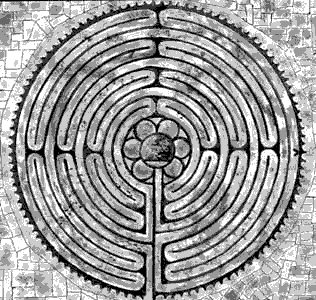"Your life is a sacred journey. And it is about change, growth, discovery, movement, transformation, continuously expanding your vision of what is possible, stretching your soul, learning to see clearly and deeply, listening to your intuition, taking courageous challenges at every step along the way. You are on the path... exactly where you are meant to be right now... And from here, you can only go forward, shaping your life story into a magnificent tale of triumph, of healing of courage, of beauty, of wisdom, of power, of dignity, and of love."
- Caroline Adams
Alex Pattakos begins his chapters on the core principle of exercising the freedom to choose your attitude by using a labyrinth as a metaphor for life.
A labyrinth, like the one in Chartres, France shown above, is NOT a maze. A maze has dead ends, stops, tricks, and traps that can challenge one as the seek the single path from the start to the end. A labyrinth has a singular entrance and exit to a path that appears to meander, but seen from above has structure and meaning. Labyrinths are intended to be walked with pauses to reflect upon the experience. As a metaphor for life, I don't know that the meaning of the labyrinth can be stated better than the writer of lessons4living.com:
We are all on the path... exactly where we need to be. The labyrinth is a model of that path.
A labyrinth is an ancient symbol that relates to wholeness. It combines the imagery of the circle and the spiral into a meandering but purposeful path. The labyrinth represents a journey to our own center and back again out into the world. Labyrinths have long been used as meditation and prayer tools.
As a tool of prayer and meditation, the labyrinth is a path that is not intended to be walked alone. Seekers share the path and those on the way inward share the path with those on their way outward; when one seeker pauses along the path, the other seekers join them in the pause.
The Chartres labyrinth is one of the best-known labyrinths in the world, but it is not the only labyrinth or design in the world. So of all of the options, how does one know that they are on the right path?
The feel os the right path is the feeling of alignment and harmony. It is the path that aligns with one's divine purpose and meeting. Remember that week one homework? You identified your purpose and meaning, are you on the right path?
Living in accordance with your purpose and meaning requires many choices and not all of them are easy. Each of us will have experiences, the actions of the world, and for every action there is a reaction. Between the action and our reaction is a space. Within that space is a choice and that choice is how we react. For many, that space is very small, almost imperceptible. When one exercises the freedom to choose their reaction (or attitude) in that space, the space enlarges and when that behavior is repeated the space between action and reaction becomes expansive. It is in those expansive spaces where choices can be made to react, or not, in ways that are in accordance with one's purpose or meaning.
Making the most of that space requires the ability to view situations with some detachment and to apply creative effort to envisioning possibilities that may not be readily apparent. Creative effort. EFFORT. Let's apply training and diligence to developing the skills that help in that creative effort. In Chapter 4, Pattakos describes the ten positive things exercise. I encourage you to work through the exercise and develop your attitude choice creative muscle.

No comments:
Post a Comment